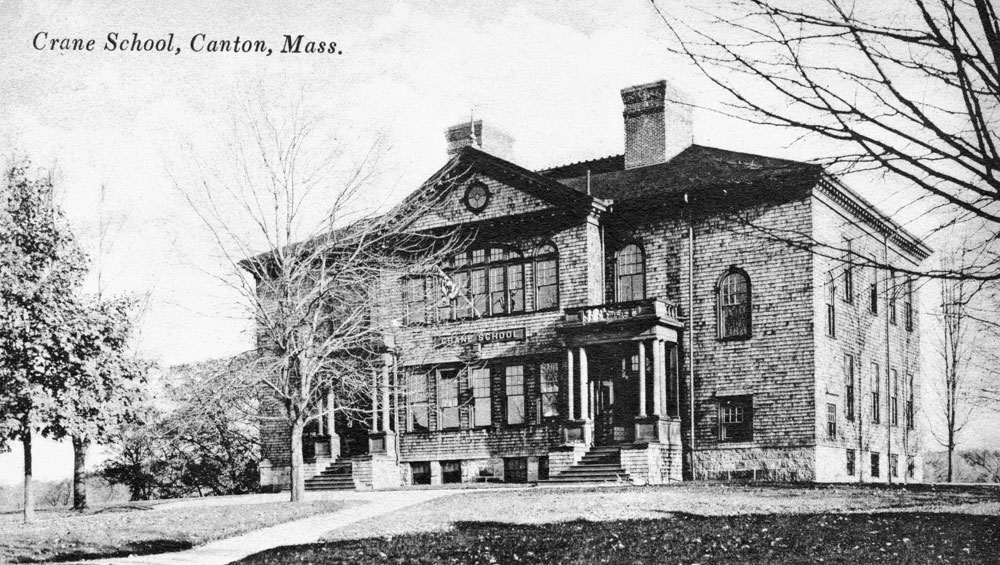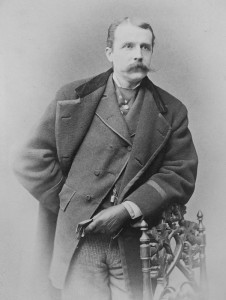True Tales from Canton’s Past: Twenty-Two Stories
By George T. Comeau
The Crane School was demolished in 1954, and the town has never been quite the same. (Collection of the author)
This column began in 2011, and since it started I have been able to tell well over 100 stories tied to the unique history and character of Canton. It has not really been all that hard discovering the things that make us unique. When you are curious, and you talk to people who have been here their whole life, you pick up snippets here and there. The rest is knowing where to find the answers.
It starts with curiosity. Asking why, who, what and when. Observing the architecture of the buildings, or the way a street meanders around an old wall. Sometimes it is a grave marker, or an old signpost. Other times, someone drops a bit of old gossip. The wife that offed the husband, the leg in the woods, the couple that was not married but had eight children, or the native princess that lost her love and then dashed herself off of balancing rock. It can be as simple as a drill hole in a rock deep in the woods, or a shard of pottery on a worksite. These are the nuggets that start the inquiry into my stories. They are not all sad; sometimes they are the joy of love, or the supreme achievement of a Nobel Prize. Yes, all future stories to share.
The next step in my research is usually a phone call. My absolute go-to call is likely to be to Jim Roache. There is no doubt that folks like Jim walk in the footsteps of so many other “townies” that he usually can continue my inquiry and fill in some of the story. At the same time, Jim is an inveterate storyteller, and he has adopted the ability to turn a yarn into reality. When you see Jim Roache, make sure you ask him about “Chicken Cacciatore,” a wild yarn that has been passed down in Canton folklore for over 60 years. The punch line is “Chicken Catch a Tory,” and I will leave it at that.
Yet, when you talk to townies, you learn a few things. First, you learn that “Canton ain’t the way it used to be.” This is due to the fact that it has become overbuilt and has never been the same since they demolished the Crane School. The Crane School was an epically large building in the center of Canton where Walgreen’s now stands. Old timers will tell you about the brick firehouse that was adjacent, and the children and carnivals that staged themselves in the field behind the school. It was sold and torn down after the town meeting disposed of the property and it became the parking lot for the A&P.
In 1947 it was observed, “The Crane School on the corner of Bolivar and Washington Streets is perhaps the best known Canton school building. Dedicated April 18, 1854, it was declared at the time as unequalled in beauty of architecture and completeness of design.” As soon as it was demolished, the town regretted the decision. All of that happened back in 1954, yet the loss still resonates. It’s funny, at a recent meeting Selectman Victor Del Vecchio said, “I have no idea what was so special about that school in Canton Center, but I do know that I hear people bemoan the loss so much that I find it critical that we find ways to maintain our legacy and not make such mistakes in judgment again.” Today, Del Vecchio is referring to the ongoing plan to transform the Plymouth Rubber site into the Paul Revere Heritage Site. Preserving our legacy has become more pronounced as a result of research and new ways to share the stories that make Canton unique.
The sentiments of the lost past are tied to the dynamic change that has transformed this town into condo after condo and vast subdivisions of “McMansions.” Townies always yearn for what was seen in hindsight as a simpler and friendlier community. What I call the “Cheers effect” — where everybody knows your name. Traffic is always worse than it ever was and the fish just are not as big as they were “back when I was a kid … and you had to be home as soon as the streetlights came on.”
And yet, the stories pour forth. Once the broad storyline emerges, then the background research begins. The Canton Public Library has a wonderful room tucked away on the main floor called the Edward Bolster Local History Room. Behind ventilated shelves are all the bound town reports, census data, street directories, government documents, and literally hundreds of documents focused on Canton. At the same time, the library has started an online local history Wiki. The Canton Wiki is a digital encyclopedia of Canton’s history that grows each month at the hands of local resident John Healy, an archivist who donates his time to the project. Most of the material is connected to the library holdings, and much of the source material comes from historians such as Daniel Keleher and Edward Lynch. These men may be gone, but their legacy lives on today, alive and well on the web.

D.T.V. Huntoon, Canton’s first great local historian (Courtesy of the Canton Historical Society)
Perhaps the greatest source of our written history comes from the seminal History of Canton by D.T.V. Huntoon. Not a single week goes by without my consulting that amazing body of work. More importantly, a second book sits by its side: Who Was Who and What Was What in the History of Canton, Mass. by Alice Reynolds. Published in 1975 to celebrate the bicentennial, this limited edition was printed to support the work of the Friends of the Little Red House — a legacy project that still continues today. Quite literally, this companion book cross-references and adds tremendously to the original history that was published in 1873. I think that I would be lost without this resource, since the original index only numbered about nine pages, and Reynolds’ book is a whopping 485 pages of indispensable dates and facts about Canton.
And today my sources are even more diverse. The entire collection of the Boston Globe and the New York Times are now online and searchable. Many of the stories that I have written that touch on national themes and local heroes are colored by the journalism of the day in which they lived or died. Moreover, colonial newspapers have been digitized and are available through the Boston Public Library online, and that helps with the 18th century articles. Meanwhile, I frequently access the Digital Public Library of America (DPLA) to find photographs and artifacts that until recently had been locked away in private societies and far-flung libraries without context to Canton.
Today, the World Wide Web creates contextual connections if you know how to follow the breadcrumbs. For one story that I wrote about a balloonist from Canton, I was able to find a photograph of his assent in 1907 as he began a cross-country journey in a hot air balloon. The photo came from the Missouri History Museum in St. Louis and was only found through a deep web search that three years ago would have been impossible. In other cases, Ancestry.com helps tell the story of neighbors through census pages that come alive when you know the historic neighborhoods of Canton. Tax records, birth and death certificates, military archives, even gravesites all can be found with a few keystrokes.
And these stories end where they begin — with people. Many of the tales I tell are written long after the individuals featured are gone. In some of the sad stories, the family burden lingers long after the tragedy, and as such I hold those stories for the future. There is a responsibility to the people who are written about. The responsibility to get the facts straight, respect the dead, understand the context, and pay homage to those who came before us. There is weight and lightness balanced in these local tales. So many people and events form who we are today, and the challenge is to make what was once ordinary now extraordinary. Every two weeks I find ways to build a new audience for these men and women so that they live forever in our hearts and in the words on this page.
Welcome to 2016, and another 22 stories of True Tales from Canton’s Past.
Short URL: https://www.thecantoncitizen.com/?p=32093










